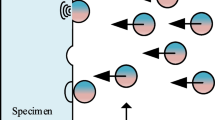Abstract
Rockwell International and Metal Improvement Company have conducted a joint test program to develop shot peening as a technique for preventing corrosion cracking in austenitic stainless steels. Initial laboratory-scale tests demonstrated the feasibility of preventing stress corrosion cracking by shot peening to impose compressive stresses on the surface of the work pieces. Conventional U-bend test specimens, when peened, survived 1000 h tests in the boiling 42 pct magnesium chloride stress corrosion test. Unpeened reference specimens commonly fractured within one or two hours in this test. Component tests were conducted to demonstrate the practicality of the peening process for sizes and shapes that typify components in a reactor piping system. Pipe sections and cold worked, hexagonal tubes were tested. In all components, unpeened sections developed stress corrosion cracks within a few hours in the magnesium chloride test; in contrast, the shot peened surfaces survived hundreds of hours. It was discovered at Rockwell International that intergranular corrosion can be prevented in austenitic stainless steels by severe shot peening prior to exposure to sensitizing temperatures. For this purpose, the surfaces must be severely cold worked by the shot peening to break up surface grains and grain boundaries. Two nondestructive testing techniques show promise as methods for measuring the stresses or cold work imparted on the surface of the work piece by peening. In one method, eddy currents are used to measure differences in electrical properties induced by cold working of metals. Another is a magnetic technique which measures the changes in magnetic properties due to the transformation of austenite to ferrite by cold working.
Similar content being viewed by others
References
E. C. Bain,et al.:The Nature and Prevention of Intergranular Corrosion in Austenitic Stainless Steels, Transactions of the American Society for Steel Testing (June 1933).
M. G. Fontana and N. D. Greene:Corrosion Engineering, p. 64, McGraw-Hill, Inc., New York, N.Y., 1967.
J. M. Lessels and R. F. Broderick: International Conference on Fatigue in Metals, Inst Mech Engrs, p. 621, 1956, London.
P. M. Winter and W. J. McDonald:Biaxial Residual Surface Stresses From Grinding and Finishing Type 304 Stainless Steel Determined by a New Dissection Technique, ASME Paper No. 68-WA/MET-9 presented at Winter Annual Meeting of ASME, December 1968.
Metals Handbook, Vol. 2, pp. 254, American Society for Metals, 1964.
Author information
Authors and Affiliations
Rights and permissions
About this article
Cite this article
Friske, W.H., Page, J.P. Shot peening to prevent the corrosion cracking of austenitic stainless steels. JMES 1, 20–32 (1979). https://doi.org/10.1007/BF02833987
Issue Date:
DOI: https://doi.org/10.1007/BF02833987




